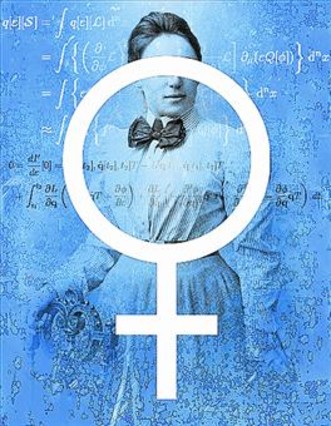 Pondering about women and science, we are limited by our timeline. Before twitter, who were the first inspiring women in science in the XIX century?
Pondering about women and science, we are limited by our timeline. Before twitter, who were the first inspiring women in science in the XIX century?
Those who had to break the mental male barriers.
What women scientists do we have to draw insight and inspiration from? Keep reading ...
In the struggle for higher education of women, the Habsburg Monarchy developed a completely individual ―facet‖. The right for free choice of career and therefore on a choice of study for all citizens, which was assured with Article 18 of the 1867 Constitution, was simply negated. The threatening loss of the civil order by women, who called in their citizen rights, forced educated citizens, to hold an unconstitutional position.
Karl Lemayer, head of a department of the ministry, mentioned ―the social order‖, whose guidance ―would still rest in the male gender‖. If women were to have ―a terrain‖ at the university, it would be impossible to limit it.
With a new decree from the Minister of Education, dated 6 May 1878, the ‗question of women‘s rights‘ was further negated at Austrian universities.
a passionate university lecturer at Munich Univ. who was vehemently against the idea of women studying medicine because they were "anatomically" inferior. He wrote about his theory down 1872 in a book entitled "The Study and the practising of medicine by women" (Das Studium und die Ausübung der Medicin durch Frauen).
One of the fiercest lobbyists against female medical students was Eduard Albert, a professor of surgery at the University of Vienna. His essay ―Women and Medical Studies‖ (1895) outlined his arguments why women were incapable of studying medicine. The real aim in life of women was ―to have children‖ and ―to weave husbands heavenly roses in their earthly life‖.
To sum up:
Patricia Mazón’s Gender and the Modern Research University: The Admission of Women to German Higher Education, 1865-1914:
SECTION 3. From a class of her own.
Emmy Noether (1882-1935)
The Greatest Female mathematician

German universities rarely accepted female students at the time. She had to beg the faculty at Erlangen to let her audit math courses. It was only after she dominated her exams that the school relented, giving her a degree and letting her pursue graduate studies.
ADD: TIMELINE FOR FEMALE EDUCATION
http://en.wikipedia.org/wiki/Timeline_of_female_education
What women scientists do we have to draw insight and inspiration from? Keep reading ...
SECTION 1. Women in medical studies
SET 1.1. USA
In America and many countries of Europe, allowing women to study at university coincided with the pressure applied by the civil women‘s movements on the governments of the individual countries.In 1842, Elizabeth Blackwell enrolled at the Medical Faculty in Geneva in the State of New York, ―inspired from the glowing thought to open the medical career for the world of women‖. After enduring resistance and vehement reactions from the academia, she successfully graduated from the Medical Faculty in 1847.By comparison, the first woman physician in the United States, Elizabeth Blackwell, received her medical license in 1859.
1864: Rebecca Crumpler became the first African-American woman to graduate from a U.S. college with a medical degree and the first and only black woman to obtain the Doctress of Medicine degree from New England Female Medical College in Boston, MA1886: Winifred Edgerton Merrill became the first American woman to earn a PhD in mathematics, which she earned from Columbia University
SET 1.2. Switzerland -Sweden -
Since 1864, women studied medicine at the University of Zurich and from 1872, in Bern and in Geneva, Switzerland.1875: Stefania Wolicka-Arnd, a Polish woman, became the first woman to earn a PhD in the modern era, which she earned from the University of Zurich in Switzerland1883 Sweden: Ellen Fries, First female Ph.D. promoted.1884 Sweden: First female medical doctor: Karolina Widerström
SET 1.3. RUSSIA
In 1867, the Russian student Nadežda Prokofjewna Suŝlova attained a doctorate in medicine at the University of Zurich.2 From the 959 female students admitted at the military-medical academy of St. Petersburg from 1872 to 1881, 609, that was 63.5 per cent, finished their medical studies and graduated.
It was disproved the most popular objections from opponents of medical studies for women:
- like the mental inability of women, because of the ―lighter weight of the woman‘s brain. ―Science and experience would have proved for a long time, that intelligence does not depend on brain mass.
- A further argument was the weaker physical strength of women. However, the successful use of female doctors in the American Wars of Secession or the Krim-War in 1877 had proved the opposite.
- A third argument was the incompatibility of profession and family, which was a weak argument, since female doctors in Russia had shown, that they could manage profession and family.
SET 2. OTHER COUNTRIES : Spain -Japan - India
- Dolors Aleu i Riera (1857–1913), first female medical doctor from Spain, 1879. she was finally allowed to take her medical practitioner's examination in 1882.
- Ogino Ginko entered Juntendo University, which was at that time a private medical academy with an all-male student body. Despite prejudice and much hardship, she graduated in 1882, and after numerous petitions, was finally allowed to take her medical practitioner's examination in 1885.
- Kei Okami studied at the Woman's Medical College of Pennsylvania, she graduated in 1889, She thus became the first Japanese woman to obtain a degree in the Western medicine.
- Kadambini Ganguly (1861–1923), the first Indian woman to obtain a medical degree in India having graduated from the Calcutta Medical College in 1886.
SET 3. GERMAN Lands.

The conservative promises Kinder, Küche, and Kirche (children, kitchen, and church), which would abolish economic exploitation in the workforce.
SET 3.1. PRUSSIA _GERMANY
Women’s entry into medical schools and the medical profession in Germany occurred relatively late in comparison with other European countries and the United States.
To receive medical certification in Prussia until 1899,
It was not until the period between 1900 and 1908 that women across Germany could attend a university.
SET 3.2. VIENA 1878
In the struggle for higher education of women, the Habsburg Monarchy developed a completely individual ―facet‖. The right for free choice of career and therefore on a choice of study for all citizens, which was assured with Article 18 of the 1867 Constitution, was simply negated. The threatening loss of the civil order by women, who called in their citizen rights, forced educated citizens, to hold an unconstitutional position.
Karl Lemayer, head of a department of the ministry, mentioned ―the social order‖, whose guidance ―would still rest in the male gender‖. If women were to have ―a terrain‖ at the university, it would be impossible to limit it.
With a new decree from the Minister of Education, dated 6 May 1878, the ‗question of women‘s rights‘ was further negated at Austrian universities.
Strong networks were created by male and female physicians, once medical
studies for women were finally allowed. They contributed to the international success of the Viennese
Medical School.
SECTION 2. Herren Profesors.
1. Theodor Ludwig Wilhelm Bischoff (1835-1843)
a passionate university lecturer at Munich Univ. who was vehemently against the idea of women studying medicine because they were "anatomically" inferior. He wrote about his theory down 1872 in a book entitled "The Study and the practising of medicine by women" (Das Studium und die Ausübung der Medicin durch Frauen).
"The laws of divine and natural order reveal "the female sex to be incapable of cultivating knowledge, and this is specially true in the fields of natural sciences and medicine"2. Eduard Albert
One of the fiercest lobbyists against female medical students was Eduard Albert, a professor of surgery at the University of Vienna. His essay ―Women and Medical Studies‖ (1895) outlined his arguments why women were incapable of studying medicine. The real aim in life of women was ―to have children‖ and ―to weave husbands heavenly roses in their earthly life‖.
To sum up:
Patricia Mazón’s Gender and the Modern Research University: The Admission of Women to German Higher Education, 1865-1914:
"Those professors expended much energy protesting women’s access to higher education, often stressing how studying would negatively affect women’s attractiveness, health, and reproductive development"
SECTION 3. From a class of her own.
Emmy Noether (1882-1935)
The Greatest Female mathematician

German universities rarely accepted female students at the time. She had to beg the faculty at Erlangen to let her audit math courses. It was only after she dominated her exams that the school relented, giving her a degree and letting her pursue graduate studies.
Her work got noticed, and in 1915, the renowned mathematician David Hilbert lobbied for the University of Göttingen to hire her. But other male faculty members blocked the move, with one arguing: "What will our soldiers think when they return to the university and find that they are required to learn at the feet of a woman?" So Hilbert had to take Noether on as a guest lecturer for four years. She wasn't paid, and her lectures were often billed under Hilbert's name. She didn't get a full-time position until 1919.
Einstein eulogy -1935:
In the realm of algebra, in which the most gifted mathematicians have been busy for centuries, Fraulein Noerther discovered methods which have proved of enormous importance in the development of the present-day younger generation of mathematicians.
Pure mathematics is, in its way, the poetry of logical ideas. ... Her unselfish, significant work over a period of many years was rewarded by he new rulers of Germany with a dismissal, which cost her the means of maintaining her simple life and the opportunity to carry on her mathematical studies.
ADD: TIMELINE FOR FEMALE EDUCATION

No comments:
Post a Comment